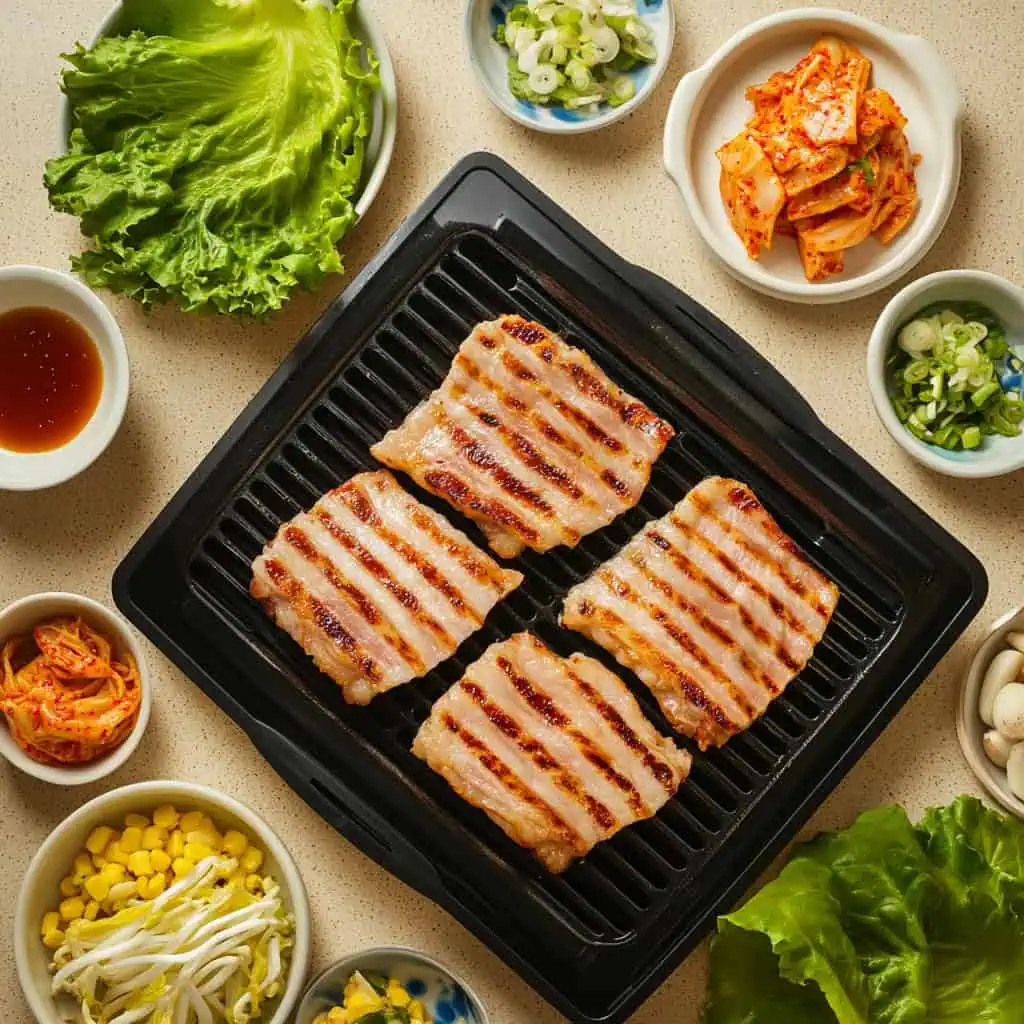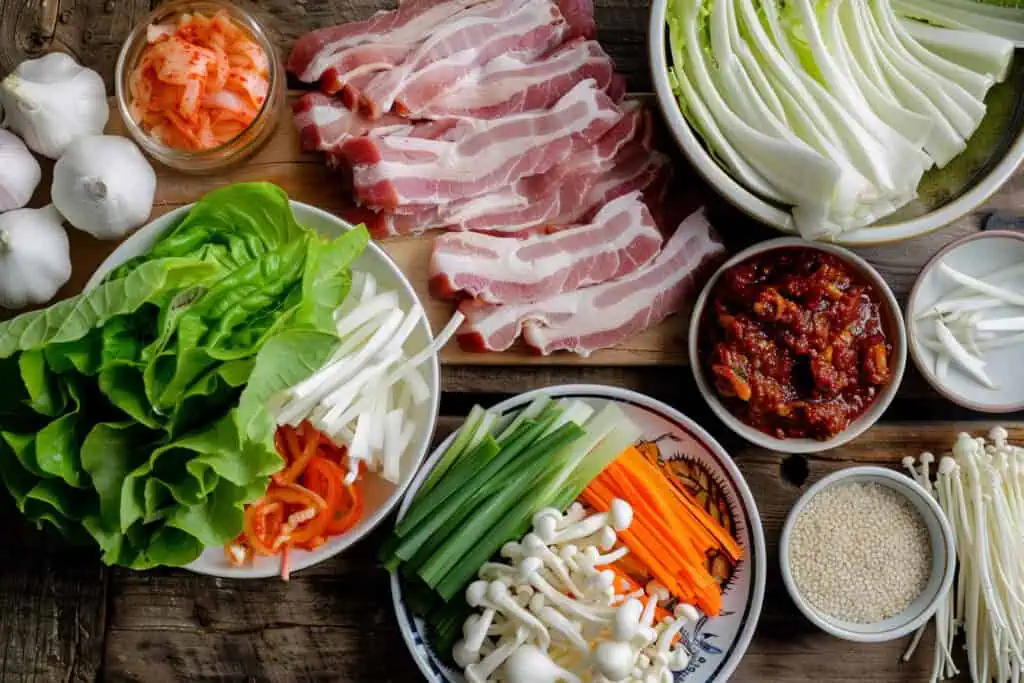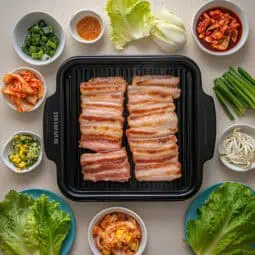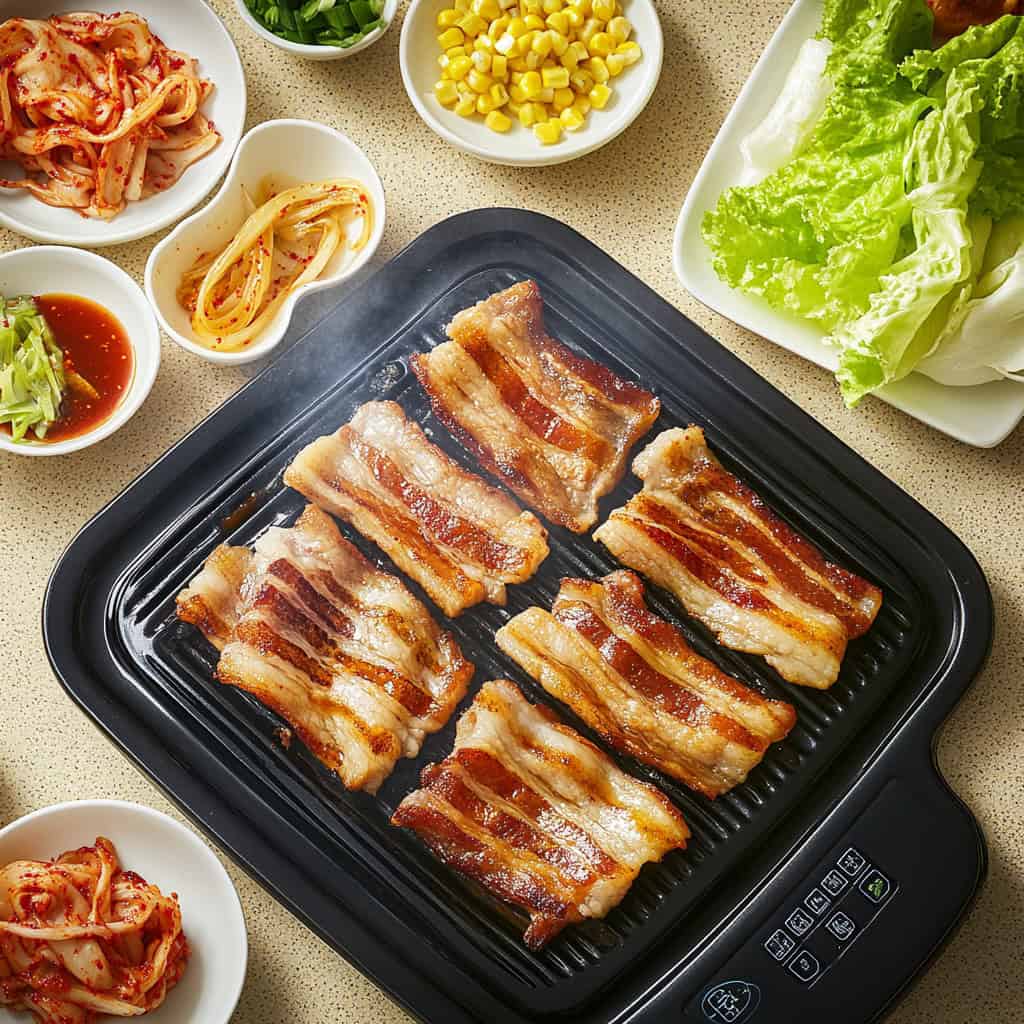As a fellow Korean BBQ/Samgyupsal lover who used to spend thousands at Romantic Baboy with my family every month, discovering how to make restaurant-worthy Samgyupsal at home was a total game-changer.
After countless trips to the palengke and Korean grocery stores (and yes, some smoky kitchen experiments), I've perfected this budget-friendly version that has become our Sunday family tradition.
Trust me, once you try this recipe, you'll be amazed at how easy it is to recreate that same mouthwatering, wrapped-in-lettuce, sauce-dripping goodness right in your own kitchen.
The best part? You can feed your whole family for the price of just one person's KBBQ restaurant bill, and there's no time limit or server rushing you to finish.
What is Samgyupsal?
Samgyeopsal (or Samgyupsal) is a beloved Korean barbecue dish featuring grilled slices of pork belly served with fresh lettuce wraps, flavorful dipping sauces, and traditional side dishes called banchan. This home version captures the interactive dining experience of popular Korean BBQ restaurants while allowing for customization and significant cost savings. The dish combines succulent, marinated meat with crisp vegetables and punchy sauces, creating perfect lettuce-wrapped parcels bursting with complementary flavors and textures.
Jump to:

Why You'll Love This Recipe
- Create an authentic Korean BBQ experience at home for a fraction of the restaurant cost
- Flexible ingredients list - customize based on your preferences
- Perfect for family gatherings or intimate dinner parties
- Most ingredients are readily available in local supermarkets
- Can be prepared ahead of time
- Interactive dining experience that brings people together
Ingredients
These ingredients create an authentic Korean BBQ experience with balanced flavors and textures. Thinly sliced pork belly provides the perfect fat-to-meat ratio, becoming crispy and juicy when grilled.
Fresh lettuce offers a cooling crunch that contrasts beautifully with the rich meat. The banchan (side dishes) add variety and traditional Korean flavors, while the marinades infuse the meat with sweet, savory, and umami notes. Gochujang and ssamjang sauces deliver that signature Korean spicy-sweet punch.
Together, these elements recreate the complete restaurant experience at home, allowing you to enjoy all the familiar tastes and interactive dining style of Samgyupsal at a fraction of the cost.

For the Meat
- 1 kilogram pork belly (liempo), sliced thinly
- and/or
- 1 kilogram beef (premium cuts like ribeye or sirloin)
Fresh Vegetables
- Fresh lettuce leaves
- Carrots, julienned
- White onions, thinly sliced
- Cucumber, sliced
- Korean pickled radish (Musaengchae)
- Enoki mushrooms
- King oyster mushrooms
- Bean sprouts
Banchan (Side Dishes)
- Store-bought or homemade kimchi
- Korean instant noodles (ramyeon)
- Tteokbokki (Korean rice cakes)
- Buttered corn
- Korean braised tofu (Dubu-jorim)
- Sweet and spicy dried anchovies
- Potato marbles (Gamja Jorim)
- Radish kimchi (Kkakdugi)
- Korean rice rolls (Kimbap)
- Scallion salad (Pa Muchim)
Spicy Pork Marinade
- 4 tablespoon gochujang paste (Korean red pepper paste)
- 2 tablespoon mirin (sweet rice wine)
- 3 tablespoon soy sauce
- 1 fresh apple or pear, pureed
- 2 tablespoon sugar
- ¼ teaspoon black pepper
- 5 cloves garlic, minced
- Salt to taste
Classic Pork Belly Marinade
- 3 green onions
- ½ onion, thinly sliced
- ½ onion, ground
- ¼ cup soy sauce
- ¼ cup sugar
- ¼ cup water
- 2 teaspoon sesame oil
- 2 teaspoon black pepper
- 1 teaspoon sesame seeds
- 1-2 teaspoon minced garlic
- 1 teaspoon chopped ginger
- Korean BBQ sauce (optional)
Dipping Sauces
Red Chili Sauce (Gochujang Sauce)
- ½ cup gochujang
- ¼ cup honey or sugar
- ¼ cup sesame oil
- 1½ teaspoon minced ginger
- 2 cloves minced garlic
Ssamjang Sauce
- ¼ cup ssamjang paste
- 1 chopped green onion
- 1 minced garlic clove
- 2 tablespoon gochujang paste
- 2 teaspoon sugar
- 2 teaspoon toasted sesame seeds
- 1 tablespoon sesame oil
Equipment Needed
- Korean Electric Grill Pan or Non-stick Pan: For grilling meat evenly without sticking. This is the centerpiece of your home Samgyupsal setup and helps create that authentic KBBQ experience.
- Tongs: Essential for safely flipping and handling meat on the hot grill surface.
- Small Bowls: For serving various banchan (side dishes) separately, allowing everyone to customize their wraps.
- Lettuce Plate: A large plate or platter to keep lettuce leaves fresh and accessible during the meal.
- Sauce Containers: Small dipping bowls to hold different sauces without mixing flavors.
- Sharp Knife: For slicing cooked meat into bite-sized pieces if not pre-sliced.
- Kitchen Scissors: Traditional Korean BBQ tool for cutting meat while cooking - easier than using a knife.

How To Make
- Marinate the meat at least 30 minutes before cooking (or ideally the night before). Choose either the spicy pork marinade or classic pork belly marinade. Coat the meat evenly and refrigerate.
- Prepare your banchan and sauces while the meat marinates. Mix the ingredients for your chosen dipping sauces and set aside in small serving bowls.
- Prepare your fresh vegetables: Wash and dry lettuce leaves, julienne the carrots, thinly slice white onions, slice cucumbers, and arrange mushrooms and bean sprouts on serving plates.
- Heat your grill or pan to medium-high heat (180-200°C/350-400°F). Pat the marinated meat dry with paper towels before grilling to achieve better browning.
- Cook the meat in batches, being careful not to overcrowd the grill. Grill for 2-3 minutes per side until properly browned and cooked through. Use scissors to cut the meat into bite-sized pieces while on the grill.
- Maintain grill temperature between 180-200°C (350-400°F) for optimal cooking. Clean the grill surface between batches to prevent burning and sticking.
- Serve immediately while hot, alongside your prepared banchan, fresh vegetables, and dipping sauces.
- For eating: Place a piece of lettuce in your palm, add grilled meat, your choice of vegetables and banchan, top with preferred sauce, then wrap and eat in one bite, ssam-style.

Tips from Lola's Kitchen
- Pat dry the meat before grilling for better browning and to prevent splattering.
- Let meat come to room temperature before grilling for more even cooking.
- Don't overcrowd the grill - cook in manageable batches for better results.
- Clean the grill between batches using a piece of onion or paper towel held with tongs to prevent burning and off-flavors.
- Prepare all banchan in advance so you can focus on grilling during mealtime.
- Buy meat when it's on sale and freeze in meal-sized portions for future use.
- Slice meat against the grain for more tender results.
- For crispier edges on pork belly, grill longer on medium heat rather than high heat.
Substitutions
- Pork belly → Pork shoulder, chicken thigh (leaner options that still provide good flavor)
- Gochujang → Sriracha mixed with miso paste (1:1 ratio for a similar spicy-savory profile)
- Mirin → White wine + sugar (1 tablespoon sugar per ¼ cup wine)
- Korean BBQ sauce → Regular BBQ sauce + sesame oil (add 1 teaspoon sesame oil per ¼ cup BBQ sauce)
- Lettuce → Cabbage leaves (provide a similar crunch with more durability)
- Enoki mushrooms → Button mushrooms (sliced thinly as a more accessible alternative)
- Ssamjang → Mix of miso paste and chili sauce (2 parts miso to 1 part chili sauce)
- Korean pickled radish → Quick-pickled daikon or carrots (for a similar tangy crunch)
Troubleshooting
Meat sticking to grill
- Make sure your grill is properly heated before adding meat
- Clean grill surface between batches
- Add a light brush of neutral oil to the grill before cooking
- Pat meat dry before placing on grill
Meat too tough
- Slice meat thinner (about 2-3mm thick works best)
- Don't overcook the meat (pork belly only needs 2-3 minutes per side)
- Try using meat tenderizer in your marinade
- Let meat marinate longer to break down fibers
Too salty marinade
- Add a bit of water or sugar to balance the saltiness
- Reduce marination time if using salty sauces
- Rinse meat briefly before cooking if extremely salty
- Serve with plain rice to balance flavors
Meat cooking unevenly
- Ensure meat slices are uniform thickness
- Let meat come to room temperature before grilling
- Rotate meat positions on the grill for even heating
- Adjust heat zones on your grill if possible
Storage & Reheating
- Marinated meat: Keep refrigerated for up to 2 days or freeze for up to 1 month
- Cooked meat: Store in airtight container for up to 3 days in the refrigerator
- Banchan: Most last 3-5 days in refrigerator in covered containers
- Reheat meat: In pan over medium heat until just warm (about 1-2 minutes) to avoid overcooking
- Dipping sauces: Keep refrigerated in airtight containers for up to 1 week
- Lettuce and fresh vegetables: Best used same day, but can be stored in damp paper towels for 1-2 days

FAQ
Can I prepare everything in advance?
Yes! Marinate meat overnight, prepare banchan and sauces a day ahead. Just slice fresh vegetables before serving for maximum crispness.
How much should I prepare per person?
Plan for 200-250g of meat per person, plus various sides. For bigger eaters or as the main meal, increase to 300g per person.
Can I use a regular pan instead of a Korean grill?
Absolutely. Any non-stick pan or cast iron skillet works well. Just cook in smaller batches and make sure to maintain good heat.
How long can I keep marinated meat?
Up to 2 days in the refrigerator, or 1 month if frozen. Thaw frozen marinated meat in the refrigerator overnight before cooking.
Is it necessary to use Korean ingredients?
While authentic ingredients give the best flavor, you can use local alternatives from the substitution list above with good results.
What can I do with leftover banchan?
Many banchan can be repurposed into fried rice, noodle dishes, or used as sandwich fillings the next day.
Do I need special charcoal for authentic flavor?
No, an electric grill or regular pan works fine. For smoky flavor, add a drop of liquid smoke to your marinade.
What's the best way to eat Samgyupsal?
The traditional way is ssam-style: wrap a piece of meat and banchan in lettuce, add sauce, and eat in one bite. But there's no wrong way - customize to your preference!
Related
Looking for other recipes like this? Try these:

Filipino Home Samgyupsal Guide (Samgyupsal sa Bahay)
Equipment
- Korean Electric Grill Pan (Electrically-heated grill plate) or Non-stick pan with gas stove For grilling meat evenly without sticking
- Tongs [Sipit] For flipping and handling meat safely
- Small bowls (mangkok) For serving various banchan (side dishes)
- Lettuce Plate (Pinggan para sa gulay) For serving fresh vegetables
- Sauce Containers (Lalagyan ng sawsawan) For different dipping sauces
- Sharp knife [Matalas na kutsilyo] For cutting grilled meat into bite-sized pieces
- Scissors (Gunting) For cutting meat while cooking
Ingredients
For the Meat (Karne)
Choose one or both:
- 1 kilogram pork belly liempo, sliced thinly
- 1 kilogram beef baka, premium cuts like ribeye or sirloin
Fresh Vegetables (Sariwang Gulay)
- Fresh lettuce leaves lettuce
- Carrots karot, julienned
- White onions sibuyas, thinly sliced
- Cucumber pipino, sliced
- Korean pickled radish Musaengchae
- Enoki mushrooms kabuteng enoki
- King oyster mushrooms kabuteng oyster
- Bean sprouts togue
Banchan (Side Dishes)
- Store-bought or homemade kimchi
- Korean instant noodles ramyeon
- Tteokbokki Korean rice cakes
- Buttered corn mais
- Korean braised tofu Dubu-jorim
- Sweet and spicy dried anchovies dilis
- Potato marbles Gamja Jorim
- Radish kimchi Kkakdugi
- Korean rice rolls Kimbap
- Scallion salad Pa Muchim
Marinade Recipes
Spicy Pork Marinade (Maanghang na Marinade)
- 4 tablespoon gochujang paste Korean red pepper paste
- 2 tablespoon mirin matamis na rice wine
- 3 tablespoon soy sauce toyo
- 1 fresh apple or pear pureed (mansanas o peras)
- 2 tablespoon sugar asukal
- ¼ teaspoon black pepper paminta
- 5 cloves garlic minced (bawang)
- Salt to taste asin
Classic Pork Belly Marinade
- 3 green onions dahon ng sibuyas
- ½ onion thinly sliced (sibuyas)
- ½ onion ground (giniling na sibuyas)
- ¼ cup soy sauce toyo
- ¼ cup sugar asukal
- ¼ cup water tubig
- 2 teaspoon sesame oil langis ng sesame
- 2 teaspoon black pepper paminta
- 1 teaspoon sesame seeds buto ng sesame
- 1-2 teaspoon minced garlic dinurog na bawang
- 1 teaspoon chopped ginger luya
- Korean BBQ sauce optional
Dipping Sauces (Sawsawan)
Red Chili Sauce (Gochujang Sauce)
- ½ cup gochujang
- ¼ cup honey or sugar
- ¼ cup sesame oil
- 1½ teaspoon minced ginger
- 2 cloves minced garlic
Ssamjang Sauce
- ¼ cup ssamjang paste
- 1 chopped green onion
- 1 minced garlic clove
- 2 tablespoon gochujang paste
- 2 teaspoon sugar
- 2 teaspoon toasted sesame seeds
- 1 tablespoon sesame oil
Instructions
- Start preparation at least 30 minutes before cooking (or ideally the night before) by marinating your choice of meat. For spicy pork marinade (maanghang na marinade), combine 4 tablespoons gochujang paste, 2 tablespoons mirin, 3 tablespoons soy sauce (toyo), pureed apple or pear (mansanas o peras), 2 tablespoons sugar (asukal), black pepper (paminta), minced garlic (bawang), and salt (asin) to taste. For classic pork belly marinade, mix soy sauce, sugar, water (tubig), sesame oil, black pepper, minced garlic, ginger (luya), and finely sliced green onions (dahon ng sibuyas). Coat the meat evenly and refrigerate.
- While the meat marinates, prepare your banchan and sauces. For the red chili sauce, combine ½ cup gochujang with ¼ cup honey, ¼ cup sesame oil, ginger, and garlic. For ssamjang sauce, mix ¼ cup ssamjang paste with chopped green onion, garlic, gochujang paste, sugar, sesame seeds, and sesame oil. Set these aside in small serving bowls (mangkok).
- Prepare your fresh vegetables (sariwang gulay): wash and dry lettuce leaves, julienne the carrots, thinly slice white onions (sibuyas), slice cucumbers (pipino), and arrange mushrooms (kabute) and bean sprouts (togue) on serving plates (pinggan).
- Heat your Korean grill or non-stick pan to medium-high heat (180-200°C/350-400°F). Pat the marinated meat dry with paper towels before grilling to achieve better browning. Place meat slices on the hot grill, being careful not to overcrowd. Cook for 2-3 minutes per side until properly browned and cooked through. Use scissors to cut the meat into bite-sized pieces while on the grill.
- As you grill, maintain the temperature between 180-200°C (350-400°F) for optimal cooking. Clean the grill surface between batches using tongs (sipit) to prevent burning and sticking. Serve the meat immediately while hot, alongside your prepared banchan, fresh vegetables, and dipping sauces.
- For eating, place a piece of lettuce in your palm, add grilled meat, your choice of vegetables and banchan, top with preferred sauce, then wrap and eat in one bite, ssam-style. Continue grilling meat as needed throughout the meal to ensure everyone enjoys hot, freshly cooked portions.
Tips from Lola's Kitchen
- Pat dry the meat before grilling for better browning
- Don't overcrowd the grill - cook in batches if needed
- Clean the grill between batches to prevent burning
- Prepare banchan in advance to focus on grilling
- Store leftover marinaded meat in an airtight container
- Buy meat when it's on sale and freeze for future use
Nutrition
The Story Behind Filipino-Style Samgyupsal
Samgyupsal (삼겹살), which literally translates to "three-layered flesh," earned its name from the three distinctive layers of meat that characterize high-quality pork belly. This beloved Korean barbecue dish emerged in the 1970s during South Korea's rapid industrialization period, when increased meat consumption became a symbol of economic prosperity.
While Korean BBQ has ancient roots dating back to the Goguryeo period (37 BC-668 AD), Samgyupsal's popularity exploded in the 1990s as Korean barbecue restaurants began spreading across Asia. The dish perfectly embodied the Korean concept of "ssam" - the art of wrapping meat in leafy vegetables - a tradition that dates back centuries and represents the harmony of different flavors and textures in Korean cuisine.
In the Philippines, Samgyupsal gained massive popularity in the mid-2010s, riding the wave of the Korean Wave or "Hallyu." What started as a trendy dining option in Metro Manila quickly became a national obsession, with Korean BBQ restaurants like Romantic Baboy, Samgyupsalamat, and Jin Joo becoming household names. Filipinos embraced the interactive dining style, which resonated with our own culture of "kamayan" and family-style eating.
Today, Samgyupsal isn't just a meal - it's a social experience that brings people together. The ritual of grilling meat, preparing lettuce wraps, and sharing countless side dishes (banchan) creates an atmosphere of connection and celebration that appeals to Filipino family values. The dish's adaptation to Filipino tastes, with local variations and adjustments in spice levels and marinades, shows how this Korean favorite has found a second home in Philippine cuisine.
This once-restaurant-exclusive experience can now be recreated at home, allowing families to enjoy premium Korean BBQ without the hefty price tag or time limits. With the right ingredients and techniques, home-cooked Samgyupsal can rival any restaurant version, making it the perfect choice for special gatherings or weekend family meals.










Comments
No Comments